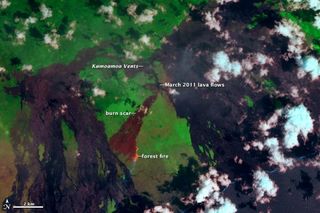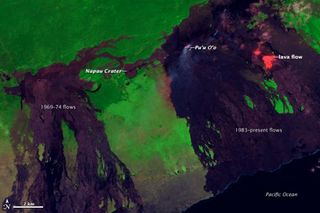
Lava from Kilauea Volcano Seen from Space

Lava from one of the world's most active volcanoes, Hawaii's Mount Kilauea, can be seen from space, as the molten flow spills toward older lava flows on the volcano's slopes.
On March 5, Kilauea surged with flows of fresh lava from the opening of a new fissure. The eruption touched off a forest fire that burned for much of the month and threatened one of Hawaii's protected rainforests, according to news reports.
After many cloud-covered days, NASA's Advanced Land Imager (ALI) on the Earth Observing-1 (EO-1) satellite captured a false-color image of the area (top image) on March 18. A similar view from Jan. 16, 2010, is provided for comparison (below image).

In the images which depict mostly infrared wavelengths of light vegetation is green, older lava flows are brown to black, and hot areas are red. In this case, the scorched land in the burn scar appears slightly red and brown, the still-burning forest fire appears bright red, and bare lava is black or very dark purple. In the 2010 image, bright red, active lava flows stand out within and near the Pu'u 'O'o crater. Volcanic craters are big holes created by volcanic activity. Magma can erupt through vents within craters.
About 8 miles (13 kilometers) east of the volcano summit and along the rift zone between Napau Crater and Puâ??u â??Oâ??o , the Kamoamoa fissure spewed fresh lava as much as 160 feet (50 meters) into the air. Lava oozed several kilometers downhill and ceased flowing on March 9, according to the Hawaii Volcano Observatory. Just before the new fissures opened, magma withdrew beneath Pu'u 'O'o, and the inner crater collapsed 377 feet (115 meters).
As of March 22, the wildfire near Kilauea had grown to about 1,924 acres and there is "no estimated containment date," Gary Wuchner of the National Park Service, told the Honolulu Star-Advertiser.
The northern edge of the fire was closing in on a special ecological area within Hawaii Volcanoes National Park.
Sign up for the Live Science daily newsletter now
Get the world’s most fascinating discoveries delivered straight to your inbox.
Kilauea is a shield volcano with a low angle and broad shape like the shields used by Hawaiian warriors of the past. They are usually built from the successive lava flows piling one on top of the other. The volcano's current active period has been ongoing since 1983.

